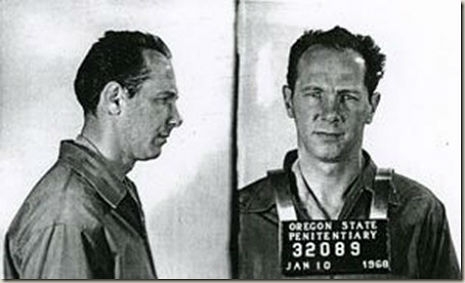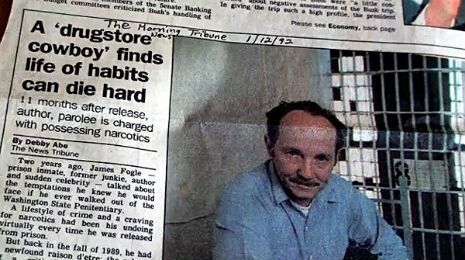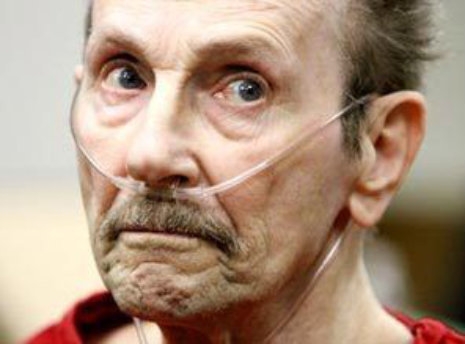
Gus Van Sant’s 1989 film Drugstore Cowboy, based on author James Fogle’s autobiographical novel about his lifelong addictions, adventures, and crimes, was an unexpected cult success. However, it did not lead to the publication (authorized, anyway) of Fogle’s other works or more films. 25 years later there is a sequel in the works, Drugstore Cowboy (Backside of a Mirror), written by Drugstore Cowboy screenwriter Daniel Yost with input from Fogle during his last years.
“The original film is almost all Fogle (though, of course, beautifully directed, acted, and photographed), as it came from a novel he sent me with the story intact and lots of dialogue,” Yost says. “The sequel started with an idea that came to me when I woke up one morning and couldn’t resist. I wrote it, then asked Jim to send me a couple of things, one being the experience of going through withdrawal. On screen this will be harrowing, rivaling what Gene Hackman’s character went through in French Connection II.”
It was Yost who first introduced then-fledgling filmmaker Van Sant to Fogle’s work and he has been an ongoing champion for its publication and development ever since. Over the years Fogle sent Yost several novels and short stories, but prior to meeting Gus Van Sant Yost was unable to get Fogle’s short stories published anywhere, even after editing and tidying them up himself.
Fogle could have become a Burroughs-like anti-hero or even a triumphant artist like Jim Carroll in 1989 upon Drugstore Cowboy’s release. He certainly had the opportunity to makeover his existence and enjoy the rewards of minor celebrity. But despite multiple attempts at clean living, his self-destructive streak remained. Much to the frustration of his friends and family, Fogle became something of a folk hero in the Northwest, with multiple arrests for (of course) expertly robbing pharmacies, with the last two times occurring in Redmond, Washington and Seattle in 2010 and 2011. All of his stories and novels were written in prison, where he spent nearly fifty of his seventy-five years, and he found it impossible to write elsewhere. At the time of his death in prison in 2012 he had been writing another novelized autobiography.

In an email interview Daniel Yost recently answered a few questions for Dangerous Minds about his experiences working with James Fogle and his plans for Drugstore Cowboy (Backside of a Mirror).
DM: How did you meet Jim Fogle? How would you describe him as a writer?
Daniel Yost: Fogle was in Washington State Penitentiary in Walla Walla when he sent Satan’s Sandbox to Tom Gaddis in Portland, author of Birdman Of Alcatraz. I was an ex-sportswriter for The Oregonian turned freelance journalist, and I got to know Tom after interviewing him for a magazine article. He called me one day and told me he received a manuscript in the mail and I needed to come by and take a look at it. I asked what it was and he refused to say. “Just get over here and read it.”
Satan’s Sandbox was a novel about a hardened con, a naive kid and a black queen in San Quentin prison. It was intoxicating and dizzying in the power of its story and the complexity and humanity of its characters. I read it in one sitting.
Jim had read a lot of books in various prisons and was a wonderful storyteller, great with dialogue. But he only had a 6th-grade education and his work was filled with grammatical mistakes and misspelled words. Tom told me I should write to the Fogle and ask if I could clean it up and fill a few plot holes in a rewrite so it would be publishable. I wrote to Fogle, he welcomed my participation and started pouring out his heart, soul and prison experiences in long letters. As first drafts, the manuscripts also sometimes had minor plot holes and structural problems. So they needed to be rewritten and retyped to be publishable. When I finished the rewrite, Tom sent it to his New York agent, who sent it out to publishers. But it was too tough, too raw for literary sensibilities. There were no takers.
Three years later Jim sent me Drugstore Cowboy. I did the same with that. Again, no takers. So I took a screenplay class and turned Satan’s Sandbox into a screenplay. Then I got a job writing a comedy for a Portland filmmaker, and during that time met local filmmaker Gus Van Sant.
By the late ‘80s I had moved to L.A. and had written several screenplays. Gus called me, said he was in L.A. and asked what I had. He had made a very low-budget 16mm film, Mala Noche, which got him an L.A. agent and manager and gave him an opportunity to make another film. We met at a deli and he asked to read Drugstore Cowboy. He said it would be a $500K movie. The rest is history.
After Drugstore, Satan’s Sandbox was optioned but not made. I’ve since written five more Fogle-related screenplays. I expanded the short story Bird’s Nest On The Ground into The Thief And The Stripper. Fogle expanded Bird’s Nest On The Ground after I wrote the screenplay. It was optioned a couple of times but not made. Doing It All was one-third from Fogle’s novel, one-third from his life, and one-third what I made up. It was optioned a few times over for several years but not made. Shotgun Wedding was inspired by a Fogle letter. Needle In The Sky came from his novel, with some additions. And I wrote a sequel to Drugstore Cowboy on my own after waking up with an idea I couldn’t resist. A producer is currently working on financing it.
Fogle’s other unpublished manuscripts still need rewriting. There is a chance that everything he wrote, including his letters over the years, will eventually be considered valuable, especially if a few more movies get made.

DM: How many of Jim’s manuscripts were published? How many do you still have?
Daniel Yost: Only Drugstore Cowboy has been published (Delta Fiction), and then only after the film began winning awards. Two years ago it was published in France.
Jim wrote the following original novels/stories, which I received in this order: Satan’s Sandbox, Drugstore Cowboy, Doing It All, House Of Worms, Reckless Endearment, Harse Apples, Gold Gold Gold, Needle In The Sky, The Just And The Unjust and “Bird’s Nest On The Ground” (a short story). He was part way through an autobiography (which read more like fiction, than “I was born…” type writing) when he died.
Also, he wrote Happy Face Killer from an unpublished autobiographical manuscript by serial killer Keith Jesperson. In 2001, without Fogle’s knowledge and permission, Harse Apples was published on Amazon as Cissy’s Magic by Fogle’s one-time cellmate Edwin Allen Lee (pen name), who added his name as co-author. Lee did the same thing with Happy Face Killer. Neither Fogle nor I knew how this happened, and Lee then died in 2007, having never contacted Fogle.
DM: How would you describe him as a person?
Daniel Yost: Jim was one of the sweetest, nicest persons I’ve known. Of course we had a trusting friendship and collaboration that remained consistent, and we shared income (less than six figures) from his writing and my screenplay options, so I never saw the other side of him. However, I met several of his friends when he was out of prison, and it was clear he was well-liked and respected by all of them. And when I visited him a few times in the large lunch hall at Monroe Correction complex northeast of Seattle before he died in 2012, it was evident he was well-liked there as well. He would laugh, quoting his mother as saying, “Jim will give you the shirt off his back, and if he doesn’t have any he’ll steal one for you.” His mother, who died in the late ‘90s and earlier worked as a special-needs counselor at the high school level, told me the thing she most regretted in life was not stopping her husband from beating the little boy.
DM: Did anyone, as far as you know, in his life intervened to try to get him to seek help for his addiction and any other issues, outside of the court system?
Daniel Yost: Jim was in and out of prison several times during the years I knew him. A couple of times he was released to halfway houses with methadone programs for addiction. And when he was younger, he would sometimes work as a machinist (also did this in prison). But I was never able to generate enough money through writing and film for him to not need a job. So he would sometimes fix up old cars with friends to sell. And stealing pharmacy drugs to sell (as well as use) was also always there as a habit and option. There was never any real outside help for addiction.
He loved to tell stories and recite some of his poems he had memorized. In 2011 when I visited him out of prison, I suggested that organizations and major bookstores might want him on the speakers’ circuit, but he shrugged off that idea. It wasn’t what he was used to or had ambition for.

James Fogle at his last sentencing hearing in 2011
DM: What were your experiences working with him over the years? How did you deal with him being arrested repeatedly?
Daniel Yost: We had a great working relationship. Mostly this involved me asking for additional material when writing screenplays (which he provided), and sending the screenplays to him for his opinion and approval. And I kept him informed in letters what was going on with screenplay options, meetings, producers, and so on. Unfortunately, attached producers were never able to finance more films. Without helping to get significant money to him through additional films, I was not able to offer much help to Jim other than friendship. Of course I was not happy to see him get arrested and return to prison. But I remembered what Tom Gaddis had told me, that many convicts get used to incarceration and almost see returning as going back home, and that some of them live better in a highly structured situation.
It hurt a lot worse to get a phone call from Jim in the middle of the night in winter when it was raining in Tacoma and he had nowhere to go. And it’s also true that everything Fogle wrote, he wrote in prison. When out, nothing. His mother told me she once found him on the floor in her bedroom crying. He felt hopeless and didn’t know what to do with himself.
A week before he died, I was at his bedside at the Monroe prison. He had mesothelioma—lung cancer from working as a steamfitter with asbestos in several prisons—but doctors were never able to definitively prove it without a large tissue sample. Lawyers in Seattle wanted to bring a case, but couldn’t without that tissue sample. Jim told me to order an autopsy so I could get a lot of money in a lawsuit. I told him if that happened I would start a drug treatment foundation in his name. Emaciated, hooked up to three tubes, he abruptly sat up and raised his voice, “The hell with that, make a movie!” After his death, he was cremated by his only living relative. No autopsy.
At his bedside, I apologized to Jim for not being able to get Doing It All made. I told him I’d make it some day and that I wanted him to promise he’d be there when it happened, in spirit if not bodily. He said, “I’ll be there.” Doing It All, perhaps the best of all possible films from his life and work, will be made. And the others also.
DM: What is the plot of Drugstore Cowboy (Backside of a Mirror)? At what point after the first book does the story begin?
Daniel Yost: It’s fifteen or so years later. Bob Hughes is sober, living with his mom, who is always after him to make his bed and put his socks away properly. He’s playing golf with Det. Gentry (now his friend), working as a machinist and going to counseling. Rick and Diane suddenly show up, both still addicts. She’s been shot in the thigh by police. All hell breaks loose. It’s a story of redemption for Bob, with his mom, his wife and himself. But with as much conflict, chaos, craziness, absurdist humor, and heartfelt closeness as the first movie.
Brief documentary about James Fogle including a 2010 interview with him: